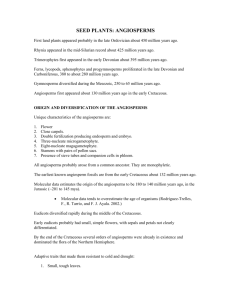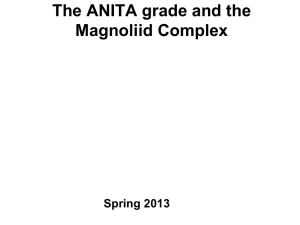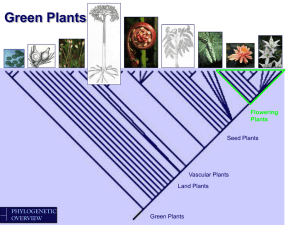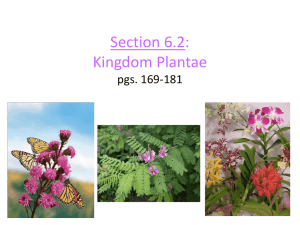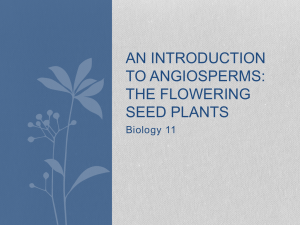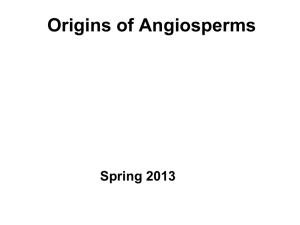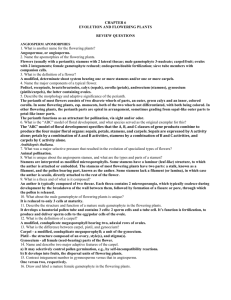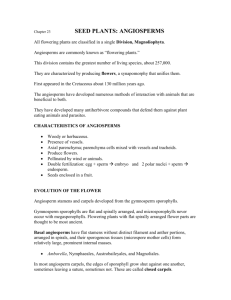13-FloweringPls
advertisement
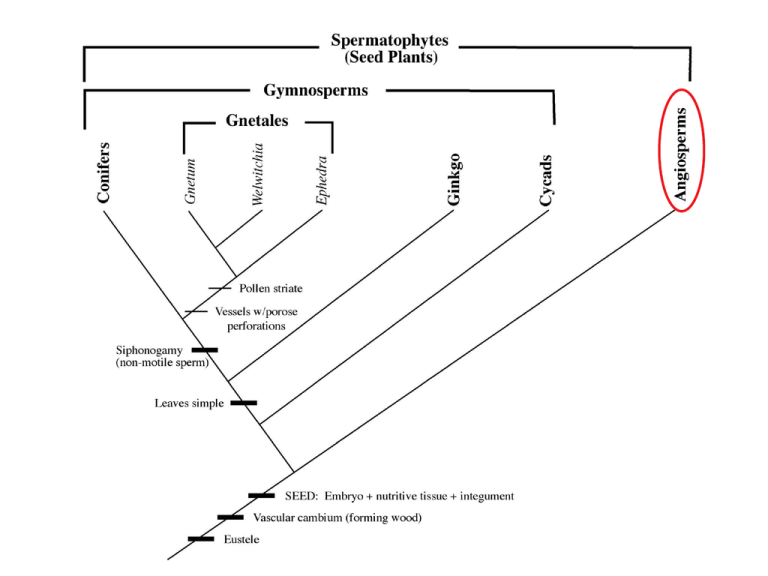
Flowering Plants - Angiosperms
Flowering Plants - Angiosperms
•
•
•
Largest group of Land Plants!
Most important economically!
Apomorphies:
1.
2.
3.
4.
5.
Flowers
Carpels
Fruits
Double fertilization with triploid endosperm
Specialized conductive cells
Why have Angiosperms been so successful?
1) Flowers
What is a flower?
= Shoot system bearing modified leaves:
Perianth
Calyx (sepals) - green, protective
Corolla (petals) - colored, attractant
Stamens - male
Carpels - female
modified
leaves
pistil
Fig. 30.7
Flower parts:
Flower pollination
(transfer of pollen to ovule):
Animal pollination
Ancestral for Angiosperms
Much more efficient means of transporting pollen
All Gymnosperms are wind pollinated
(Some Angiosperms secondarily wind pollinated)
Strategy of animal pollination:
Attractant
Visual: large or brightly colored perianth
Olfactory (smell): sweet or rotten (fetid) odor
Reward
Usually nectar or pollen
(Rarely waxes, oils)
Pollination Mechanisms
Insects
Bees
Butterflies/Moths
Flies
Birds
Bats
Water
Wind
Bee-pollinated
Moth-pollinated
Fly-pollinated
Bird-pollinated
Bat-pollinated
Wind pollination in grasses
Phyllospadix torreyi
Surf-Grass
Water-pollinated
2) Carpels
Carpel = conduplicate megasporophyll
Conduplicate = folded
Megasporophyll = “female leaf, bearing seeds”
Carpel totally encloses ovules/seeds
Carpels can fuse together
Gynoecium = all female parts
Pistil = ovary + style + stigma
Pistil can be one carpel or many
orange: 8 fused carpels
carpel
Function of Carpel
1. Protects young seeds
2. Site of pollen germination
- Can induce self-incompatibility reactions
3. Fruits
Self-incompatibility
- Pollen will not germinate on genetically similar individuals
- Promotes outcrossing
3) Fruits
Fruit = mature ovary
(plus accessory parts)
Function: seed dispersal
Fruit types:
dry
- dispersed
mechanically,
by wind, water,
etc.
fleshy
- dispersed by
animals
4) Double fertilization in Angiosperms
Assignment:
Study Figs.
38.2, 38.3,
38.5
Double fertilization in Angiosperms
Pollen produces 2 sperm
cells:
Double fertilization in Angiosperms
Pollen produces 2 sperm cells:
sperm (n) + egg (n)
----> zygote (2n)
sperm (n) + 2 polar nuclei (n)
----> endosperm (3n)
Triploid endosperm is
nutritive tissue
in seeds of Angiosperms.
Extra set of genes may
help in:
1) rapid development
2) increase genetic variation
Gymnosperms:
- Fertilization occurs long after pollination
- Seeds mature slowly (1-2 years)
Angiosperms:
- Fertilization occurs soon after pollination
- Seeds produced rapidly
- Selective advantage (e.g., annual herbs)
5) Specialized conductive cells
Most Angiosperms have vessels
Specialized in having perforation plates
vessel
perforation plate
All Angiosperms have sieve tube members
-with sieve plates: bigger pores in end walls
big
callose-lined
pores
Angiosperms
Vessels and sieve tube members
more efficient in water / sugar conduction
Angiosperm Classification
seed coat
endosperm
Old classification:
2 cotyledons
{
epicotyl
Dicots
- 2 cotyledons (seed leaves)
embryo
hypocotyl
radicle
NON-MONOCOT
Monocots
- 1 cotyledon
1 cotyledon
1 cotyledon
coleoptile
epicotyl
hypocotyl
radicle
coleorhiza
epicotyl
embryo
radicle
MONOCOTS
Monocots
monophyletic
Monocot
apomorphies
Monocot apomorphies
1 cotyledon
1 cotyledon
coleoptile
epicotyl
epicotyl
hypocotyl
radicle
coleorhiza
embryo
radicle
MONOCOTS
1 cotyledon
parallel
venation
stem an atactostele
-many scattered vascular bundles (wood lost!)
Monocots include:
Palms
Orchids
Irises
Grasses, etc.
“Dicots”
paraphyletic!
Features that defined “Dicots”
are primitive (not apomorphies)
Eudicots
monophyletic!
Eudicot apomorphy:
A
A
A
Pollen tricolpate - 3 apertures
All other Angiosperms:
aperture
Pollen has 1 aperture
Eudicots include most angiosperms:
Roses
Legumes
Daisies
Oaks, etc.
